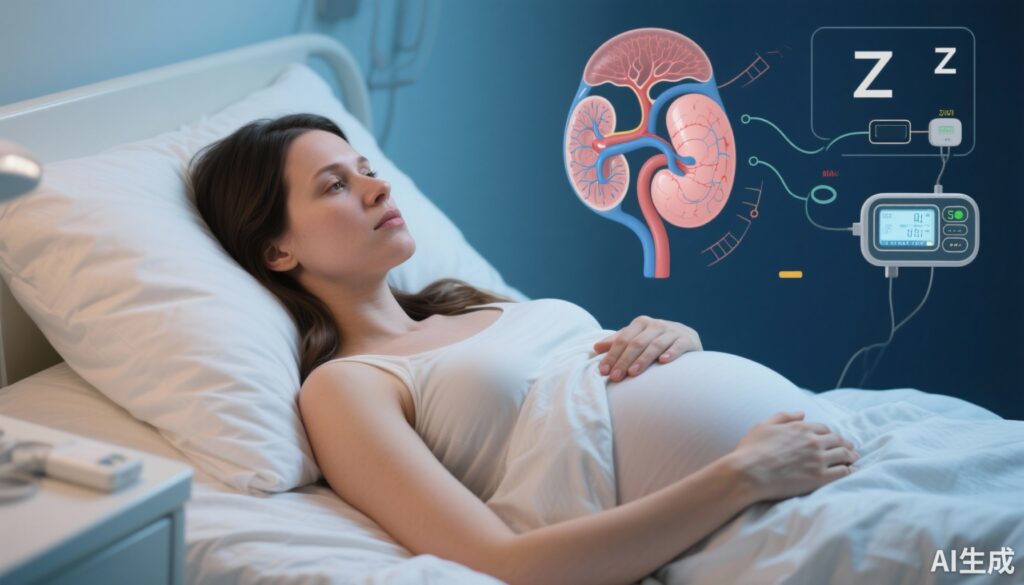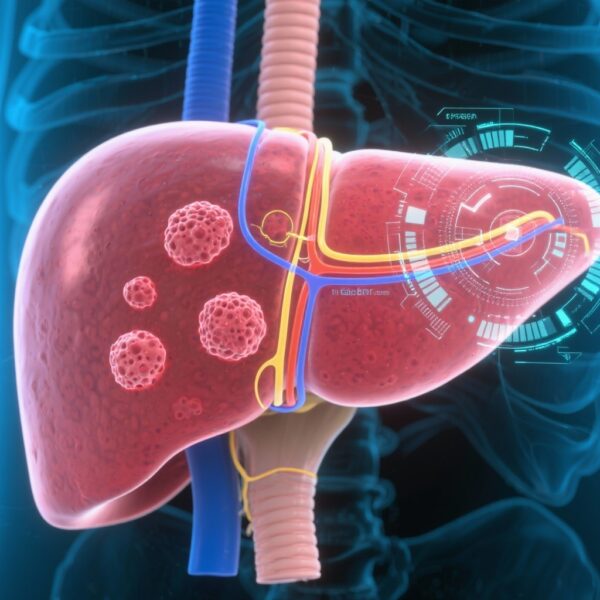Highlight
- Insomnia and obstructive sleep apnea (OSA) during pregnancy are linked to higher risks of ischemic placental disease (IPD), including preeclampsia, placental abruption, and small for gestational age (SGA) neonates.
- Both sleep disorders significantly increase the risk of severe maternal morbidity (SM) and preterm birth compared with pregnancies unaffected by sleep disturbances.
- Insomnia and OSA show distinct risk profiles, with insomnia associated with a notably higher risk of delivering SGA neonates.
- Early recognition and targeted interventions for sleep disorders in pregnancy could potentially improve maternal and neonatal outcomes, although further research is needed on underlying mechanisms and treatment efficacy.
Study Background and Disease Burden
Sleep disorders, including insomnia and obstructive sleep apnea (OSA), are increasingly recognized as significant contributors to maternal and perinatal complications. Insomnia—characterized by difficulty initiating or maintaining sleep—and OSA—marked by repetitive upper airway obstruction during sleep—both adversely affect cardiovascular and metabolic homeostasis. Previous epidemiological studies have linked these conditions to hypertension, diabetes, and systemic inflammation, factors implicated in adverse pregnancy outcomes. However, the association between maternal sleep disorders and ischemic placental disease (IPD) encompassing preeclampsia, placental abruption, and growth restriction remains insufficiently characterized at the population level.
Ischemic placental disease contributes substantially to maternal and neonatal morbidity and mortality worldwide. Identifying modifiable risk factors such as sleep disturbances provides an opportunity to mitigate these adverse outcomes. In this context, the referenced large cross-sectional study offers a comprehensive evaluation of the relationship between insomnia, OSA, and pregnancy complications within a diverse, statewide population.
Study Design
This population-based cross-sectional study analyzed data from 4,145,096 singleton live births in California from January 1, 2011, to December 31, 2020. Data linkage with birth certificates enabled the identification of maternal sleep disorder diagnoses including insomnia and OSA. The study cohort included birthing individuals aged 13 to 55 years.
Exposures were clinically documented insomnia and OSA during pregnancy. The primary outcomes were ischemic placental disease (IPD), defined as the occurrence of any of preeclampsia, placental abruption, or birth of a neonate small for gestational age (SGA), and severe maternal morbidity (SM), as per Centers for Disease Control and Prevention (CDC) criteria.
Adjusted relative risks (ARRs) with 95% confidence intervals (CIs) were calculated to quantify associations, controlling for potential confounders such as maternal age, race/ethnicity, body mass index, comorbidities, and socioeconomic status. Analyses compared risks between those with insomnia, OSA, and neither condition.
Key Findings
During the study period, 4783 (0.1%) birthing individuals had insomnia and 5642 (0.1%) had OSA, with the vast majority (99.7%) unaffected by either condition. The prevalence corresponded to 116 cases of insomnia and 136 cases of OSA per 1000 live births, reflecting a substantial burden of sleep disturbances in pregnancy.
Compared with patients without sleep disorders, those with insomnia exhibited a 42% increased adjusted risk of any ischemic placental disease (ARR 1.42; 95% CI, 1.35–1.50), while those with OSA had a slightly higher risk (ARR 1.57; 95% CI, 1.50–1.64). Notably, the risk of delivering a small for gestational age neonate was elevated with insomnia (ARR 1.23; 95% CI, 1.13–1.35) but was not as prominent with OSA.
Risk of IPD and PTB by Sleep Disorder in a Cross-Sectional Study of Singleton Live Births in California, 2011-2020.
| Outcome | Patients, No. (%) | RR (95% CI) | ARR (95% CI)a |
|---|---|---|---|
| No IPD or PTB | |||
| No insomnia or OSA | 3 396 011 (82.1) | NA | NA |
| Insomnia | 3377 (70.6) | NA | NA |
| OSA | 3794 (67.3) | NA | NA |
| Any IPDb | |||
| No insomnia or OSA | 738 660 (17.9) | 1 [Reference] | 1 [Reference] |
| Insomnia | 1406 (29.4) | 1.64 (1.56-1.73) | 1.42 (1.35-1.50) |
| OSA | 1848 (32.8) | 1.83 (1.75-1.92) | 1.57 (1.50-1.64) |
| Any preeclampsiab | |||
| No insomnia or OSA | 173 229 (4.2) | 1 [Reference] | 1 [Reference] |
| Insomnia | 492 (10.3) | 2.62 (2.40-2.86) | 1.84 (1.68-2.01) |
| OSA | 1126 (20.0) | 4.72 (4.45-5.00) | 2.26 (2.13-2.40) |
| Preeclampsia with severe featuresb | |||
| No insomnia or OSA | 93 247 (2.3) | 1 [Reference] | 1 [Reference] |
| Insomnia | 357 (7.5) | 3.58 (3.22-3.97) | 2.31 (2.08-2.57) |
| OSA | 857 (15.2) | 6.90 (6.45-7.37) | 2.86 (2.67-3.06) |
| Preeclampsia without severe featuresb | |||
| No insomnia or OSA | 85 651 (2.1) | 1 [Reference] | 1 [Reference] |
| Insomnia | 168 (3.5) | 1.93 (1.66-2.24) | 1.46 (1.26-1.70) |
| OSA | 329 (5.8) | 3.24 (2.91-3.61) | 1.77 (1.59-1.97) |
| Placental abruption | |||
| No insomnia or OSA | 40 194 (1.0) | 1 [Reference] | 1 [Reference] |
| Insomnia | 97 (2.0) | 2.39 (1.96-2.91) | 1.83 (1.50-2.23) |
| OSA | 102 (1.8) | 2.24 (1.84-2.72) | 1.83 (1.50-2.22) |
| Birth of SGA neonatec | |||
| No insomnia or OSA | 359 678 (8.7) | 1 [Reference] | 1 [Reference] |
| Insomnia | 497 (10.4) | 1.33 (1.23-1.46) | 1.23 (1.13-1.35) |
| OSA | 397 (7.0) | 0.99 (0.90-1.09) | 1.07 (0.97-1.18) |
| Preterm birth, by gestational age | |||
| All <37 wk | |||
| No insomnia or OSA | 279 364 (6.8) | 1 [Reference] | 1 [Reference] |
| Insomnia | 711 (14.9) | 2.29 (2.13-2.46) | 1.81 (1.68-1.95) |
| OSA | 870 (15.4) | 2.45 (2.30-2.62) | 1.73 (1.62-1.85) |
| <28 wk | |||
| No insomnia or OSA | 14 639 (0.4) | 1 [Reference] | 1 [Reference] |
| Insomnia | 47 (1.0) | 3.20 (2.40-4.26) | 2.42 (1.81-3.23) |
| OSA | 55 (1.0) | 3.33 (2.55-4.34) | 2.10 (1.61-2.75) |
| 28 to <32 wk | |||
| No insomnia or OSA | 21 380 (0.5) | 1 [Reference] | 1 [Reference] |
| Insomnia | 93 (1.9) | 4.28 (3.49-5.25) | 3.11 (2.53-3.82) |
| OSA | 97 (1.7) | 3.98 (3.26-4.86) | 2.47 (2.02-3.03) |
| 32 to <34 wk | |||
| No insomnia or OSA | 27 063 (0.7) | 1 [Reference] | 1 [Reference] |
| Insomnia | 96 (2.0) | 3.50 (2.86-4.27) | 2.55 (2.08-3.12) |
| OSA | 133 (2.4) | 4.28 (3.61-5.08) | 2.75 (2.32-3.27) |
| 34 to <37 wk | |||
| No insomnia or OSA | 216 282 (5.2) | 1 [Reference] | 1 [Reference] |
| Insomnia | 475 (9.9) | 2.06 (1.88-2.25) | 1.65 (1.51-1.81) |
| OSA | 585 (10.4) | 2.23 (2.06-2.42) | 1.61 (1.48-1.75) |
Preterm birth risk was increased in both groups, with ARRs of 1.81 (95% CI, 1.68–1.95) for insomnia and 1.73 (95% CI, 1.62–1.85) for OSA compared with those without disorders. Of critical concern, severe maternal morbidity was over two-fold more likely among patients with insomnia (ARR 2.26; 95% CI, 2.03–2.50) and nearly three-fold higher in those with OSA (ARR 2.81; 95% CI, 2.58–3.06).
Risk of Severe Maternal Morbidity by Sleep Disorder in a Cross-Sectional Study of Singleton Live Births in California, 2011-2020a.
| Outcome | Patients, No. (%) | RR (95% CI) | ARR (95% CI)b |
|---|---|---|---|
| No severe morbidity | |||
| No insomnia or OSA | 4 040 814 (97.7) | NA | NA |
| Insomnia | 4417 (92.4) | NA | NA |
| OSA | 5097 (90.3) | NA | NA |
| Any severe morbidity | |||
| No insomnia or OSA | 93 857 (2.3) | 1 [Reference] | 1 [Reference] |
| Insomnia | 366 (7.7) | 3.37 (3.04-3.74) | 2.26 (2.03-2.50) |
| OSA | 545 (9.7) | 4.26 (3.91-4.63) | 2.81 (2.58-3.06) |
| Severe morbidity without blood transfusions | |||
| No insomnia or OSA | 45 419 (1.1) | 1 [Reference] | 1 [Reference] |
| Insomnia | 231 (4.8) | 4.47 (3.93-5.09) | 2.74 (2.40-3.12) |
| OSA | 394 (7.0) | 6.46 (5.85-7.13) | 3.76 (3.40-4.16) |
| Acute kidney failure | |||
| No insomnia or OSA | 4969 (0.1) | 1 [Reference] | 1 [Reference] |
| Insomnia | 28 (0.6) | 5.12 (3.54-7.44) | 2.48 (1.70-3.61) |
| OSA | 53 (0.9) | 8.38 (6.39-10.98) | 3.50 (2.65-4.61) |
| Acute respiratory distress syndrome | |||
| No insomnia or OSA | 4571 (0.1) | 1 [Reference] | 1 [Reference] |
| Insomnia | 50 (1.1) | 9.91 (7.50-13.09) | 4.96 (3.73-6.60) |
| OSA | 85 (1.5) | 14.52 (11.71-17.99) | 7.19 (5.76-8.97) |
| Disseminated intravascular coagulation | |||
| No insomnia or OSA | 10 200 (0.3) | 1 [Reference] | 1 [Reference] |
| Insomnia | 32 (0.7) | 2.86 (2.02-4.04) | 2.38 (1.68-3.37) |
| OSA | 34 (0.6) | 2.63 (1.88-3.69) | 2.27 (1.62-3.19) |
| Blood transfusion | |||
| No insomnia or OSA | 46 876 (1.1) | 1 [Reference] | 1 [Reference] |
| Insomnia | 142 (3.0) | 2.72 (2.30-3.20) | 2.10 (1.78-2.48) |
| OSA | 175 (3.1) | 2.89 (2.50-3.36) | 2.29 (1.97-2.66) |
| Eclampsia | |||
| No insomnia or OSA | 6379 (0.2) | 1 [Reference] | 1 [Reference] |
| Insomnia | 26 (0.5) | 3.71 (2.53-5.46) | 2.68 (1.82-3.95) |
| OSA | 35 (0.6) | 4.33 (3.10-6.03) | 3.09 (2.21-4.33) |
| Puerperal cerebrovascular disorders | |||
| No insomnia or OSA | 2104 (0.1) | 1 [Reference] | 1 [Reference] |
| Insomnia | 19 (0.4) | 8.23 (5.24-12.93) | 4.23 (2.67-6.70) |
| OSA | 14 (0.3) | 5.26 (3.11-8.90) | 2.64 (1.55-4.49) |
| Pulmonary edema and/or acute heart failure | |||
| No insomnia or OSA | 3246 (0.1) | 1 [Reference] | 1 [Reference] |
| Insomnia | 16 (0.3) | 4.50 (2.75-7.35) | 1.86 (1.14-3.06) |
| OSA | 88 (1.6) | 21.14 (17.11-26.13) | 6.70 (5.38-8.35) |
| Sepsis | |||
| No insomnia or OSA | 13 456 (0.3) | 1 [Reference] | 1 [Reference] |
| Insomnia | 70 (1.5) | 4.70 (3.71-5.94) | 2.66 (2.10-3.37) |
| OSA | 75 (1.3) | 4.37 (3.48-5.48) | 2.65 (2.11-3.34) |
| Shock | |||
| No insomnia or OSA | 3264 (0.1) | 1 [Reference] | 1 [Reference] |
| Insomnia | 20 (0.4) | 5.58 (3.60-8.67) | 3.61 (2.31-5.63) |
| OSA | 19 (0.3) | 4.60 (2.93-7.22) | 3.36 (2.13-5.31) |
| Air or thrombotic embolism | |||
| No insomnia or OSA | 1969 (0.1) | 1 [Reference] | 1 [Reference] |
| Insomnia | 16 (0.3) | 7.41 (4.53-12.12) | 3.72 (2.36-6.13) |
| OSA | 20 (0.4) | 8.03 (5.17-12.47) | 3.25 (2.07-5.08) |
| Hysterectomy | |||
| No insomnia or OSA | 3368 (0.1) | 1 [Reference] | 1 [Reference] |
| Insomnia | 15 (0.3) | 4.06 (2.45-6.75) | 3.02 (1.81-5.04) |
| OSA | 17 (0.3) | 3.99 (2.48-6.43) | 2.46 (1.52-3.98) |
| Ventilation | |||
| No insomnia or OSA | 1403 (0.0) | 1 [Reference] | 1 [Reference] |
| Insomnia | 23 (0.5) | 14.92 (9.88-22.53) | 6.29 (4.11-9.63) |
| OSA | 95 (1.7) | 52.72 (42.83-64.89) | 25.29 (20.11-31.80) |
These results underscore the significant and independent associations of maternal sleep disorders with key adverse pregnancy outcomes. The slightly greater risk magnitude associated with OSA for IPD and SM aligns with known pathophysiological mechanisms involving hypoxia and systemic inflammation, yet insomnia’s association with SGA highlights the complexity and multifactorial nature of sleep disorder impacts.
Expert Commentary
The study by Ross et al. represents the largest population-based investigation published to date linking maternal insomnia and OSA to ischemic placental disease and severe morbidity. Its strengths include the extensive sample size, rigorous adjustment for confounders, and the stratification of sleep disorders enabling direct risk comparisons.
However, as a cross-sectional design, it cannot definitively ascertain causal relationships. Potential misclassification or underdiagnosis of sleep disorders based on clinical coding may attenuate true associations. The study population predominately comprised Californian births, which might affect generalizability to other geographic or ethnic populations.
Mechanistically, OSA may promote placental ischemia and vascular dysfunction through intermittent hypoxia, oxidative stress, and sympathetic activation. Insomnia’s association may be mediated by chronic stress responses, alterations in circadian rhythms, and inflammatory pathways. Current clinical guidelines increasingly recognize OSA screening during pregnancy, especially in high-risk individuals, but insomnia remains under-addressed despite its prevalence.
Further prospective cohorts and interventional studies are needed to elucidate underlying mechanisms, assess causal pathways, and evaluate whether targeted management of sleep disorders can improve gestational outcomes. Integrating sleep assessments into prenatal care protocols could enable timely identification and intervention.
Conclusion
This landmark population-based study highlights that both insomnia and obstructive sleep apnea during pregnancy are significant risk factors for ischemic placental disease, severe maternal morbidity, and preterm birth. The distinct risk profiles of these sleep disorders necessitate tailored clinical consideration.
Healthcare providers should be vigilant about screening for sleep disturbances in pregnant patients, recognizing their potential impact on maternal-fetal health. Multidisciplinary approaches incorporating sleep medicine, obstetrics, and maternal-fetal medicine are warranted to develop effective preventive and therapeutic strategies.
Ongoing research must focus on clarifying biologic mechanisms linking sleep disruptions to placental dysfunction and adverse pregnancy outcomes, as well as testing intervention efficacy to ultimately enhance maternal and neonatal health worldwide.
References
Ross N, Baer RJ, Oltman SP, Gossett DR, Aurora RN, Jelliffe-Pawlowski L, Brandt JS. Ischemic Placental Disease and Severe Morbidity in Pregnant Patients With Sleep Disorders. JAMA Netw Open. 2025 Sep 2;8(9):e2532189. doi:10.1001/jamanetworkopen.2025.32189 IF: 9.7 Q1 . PMID: 40956578 IF: 9.7 Q1 ; PMCID: PMC12441874 IF: 9.7 Q1 .
Louis JM, Auckley D, Miladinovic B, et al. Perinatal Outcomes Associated With Obstructive Sleep Apnea in Pregnancy. Am J Obstet Gynecol. 2012;207(1):e1-e8.
Bourjeily G, Raker C, Chalhoub M, et al. Pregnancy and Sleep-Disordered Breathing: Diagnosis, Pathophysiology, and Management. Am J Respir Crit Care Med. 2010;182(6):622-629.
Facco FL, Ouyang DW, Zee PC, Grobman WA. Sleep Disturbances in Pregnancy. Obstet Gynecol. 2017;129(5):1085-1096.




